
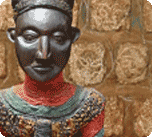 |
|
| Babungo museum | |
| Permanent exhibition | |
| Informations | |
Society and Religion
Society
The kingdom is divided into quarters, each made up (depending on its extension) of one or more lineages including several compounds (hamlets or households). Each hamlet corresponding to a family has at its head a chief, the tiifu, who is responsible for the peace, prosperity and religious rites for the well being of his family. Over the chiefs of the hamlets, there is the tiintih, the head of the quarter appointed by the king whom he represents in the district under his administration. His function is also hereditary. The king, some quarters heads appointed by him and some powerful common titled notables (the veshi / sing shi ) make up the councils of « five » and « seven » notables, themselves chiefs of lineages that form the theocratic government of the kingdom. The founders of these lineages often participated in the foundation of Babungo.Thus Bah, first assistant of the fon and chief of the council of the « five » (headquarters of the ngumba) was the successor of the ancestor of the same name. This brother of Saingi I who took part in the foundation of the kingdom. |
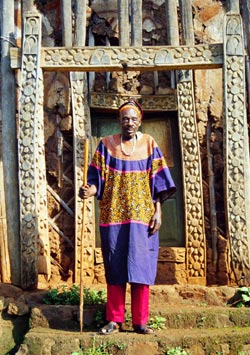 |
|
 |
Fuanje, chief of the council of the « 7 » and spokesman of the ngumba, represents another brother of Saingi I and co-founder of Babungo. The number of members of these assemblies has increased over the centuries, especially as « five » and « seven » are symbolic figures with deeper meanings. The general assembly grouping together the members of the councils of the « five » and of the « seven », the king, the group of titled servants veshi sitting at the large house of the tifuan(tifoa, ngumba or kwifo) forms the central elements of this institution, the counter power of the king and symbol of Babungo and executive body of the decisions of the government. The tifuan comprises several lodges, « houses » or autonomous societies each with its speciality and possessing specific cultural objects. If the princes are excluded from the tifuan, the common servants play a fundamental role in it. | |
Apart from the tifuan, there exists a diversity of customary societies in Babungo and which can be classified according to their functions (political, military such as the samba or njong, religious, etc.) their meeting places, social stratification (societies of princes such as the nintai), gender (societies of women such as the fembwei, etc.). |
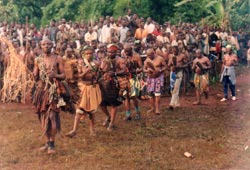 |
|
Common notables also have to be distinguished from those of royal blood, including the nchio, the queen mother who plays an important role in the country. Various elements of material culture are used as emblems or symbols indicating the social rank of each, legitimising the power and authority of the king, of the notables, of the customary societies and of the different social categories.
Religion
Despite the current spread of Islam and Christianity in Babungo, the majority of the inhabitants remain attached to the autochthonous religion that plays a fundamental role in community life, intervening in the production and use of certain objects of cult. Many Islamised and Christianised Babungo occasionally practise the religion of their ancestors. The Babungo believe in the Supreme Being Moh-Mbi or Nwi, the creator of the world, but that can only be reached with sacrifices and prayers through the intermediary of ancestors or divinities (spirits). These live at the foot of a tree, in a waterfall, lake, river, rock, sculpture or a sacred place, etc.. There are specific divinities and sanctuaries for the family, the lineage, the quarter and the kingdom. The first and most important of the gods is Ngesekwa who lives in a waterfall at Forghai.Appropriate specialists at family and local level as well as at the level of the kingdom, venerate these divinities and perform various rituals for the collective well-being. |
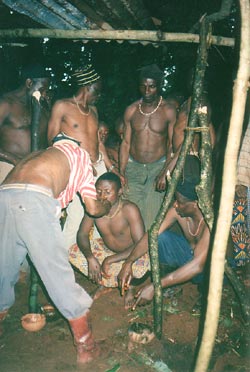 |
|
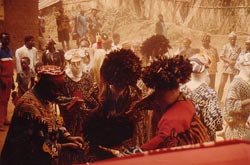 |
The Babungo believe and fear the actions of the dead, in particular of the ancestors on the living. It is the cult of the ancestors that is at the basis of the autochthonous religion. There is a proliferation of other beliefs of the Babungo dealing with divining, cursing, increasing power and the appropriation of certain qualities of man through an alliance with animals, plants, the forces of nature, witchcraft and magic. All these beliefs give rise to rites using specific material, recipients, headdresses, costumes, musical instruments, painted, woven or sculpted figures. |
|
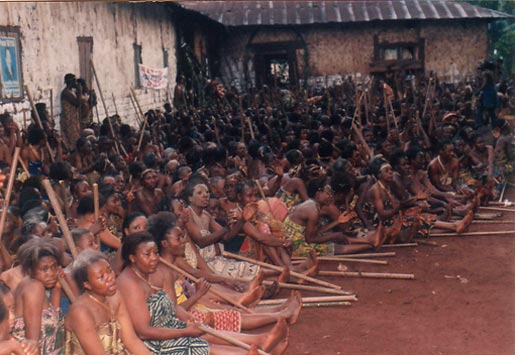
![]() Funeral ceremony, mourning the lost of king Zofoa II
Funeral ceremony, mourning the lost of king Zofoa II
All these symbols and all these beliefs are materialised and take on rhythm through the plastic arts, music and dance. Certain objects, home to redoubtable forces cannot be exhibited or handled without special precautions being taken.
|
|
|
|
[ Top page ]
| Home | The four museums | The project | Baham museum | Bandjoun museum | Mankon museum | Babungo museum |
| babungo@museumcam.org | Copyright 2005 C.O.E. | Powered by SYNUS |


















